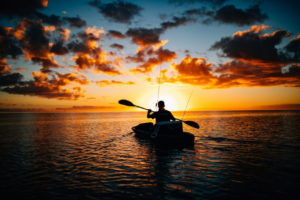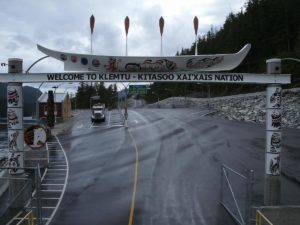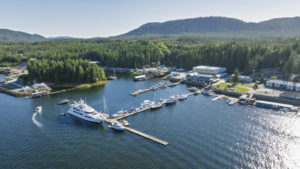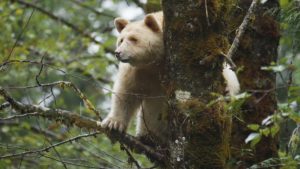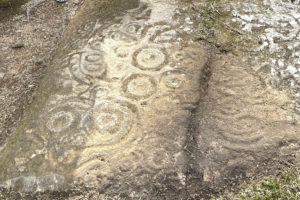Deep in the heart of British Columbia lies a lush emerald wonderland, a testament to the unyielding spirit of nature. A land where ancient trees stretch towards the heavens and the rhythm of life reverberates in harmony. This is the Great Bear Rainforest, home to the mesmerizing spectacle of the Great Salmon Run, a breathtaking ballet of life and death that drives the very heartbeat of this pristine ecosystem.
In this blog, we invite you to join us on a journey through the enchanted world of the Great Bear Rainforest, as we unravel the mysteries of the Great Salmon Run and discover the delicate balance that sustains this extraordinary natural wonder.
The Life Cycle of Salmon: A Journey of Epic Resilience
The Great Salmon Run is a testament to the resilience and determination of the five Pacific salmon species: Chinook, Coho, Sockeye, Pink, and Chum. Born in the freshwater streams of the Great Bear Rainforest and throughout British Columbia’s coast, these remarkable fish embark on an arduous journey to the open ocean, where they grow and mature before returning to their natal streams to spawn and complete their life cycle.
Overview of the Five Pacific Salmon Species
Each salmon species has its own unique traits, from the mighty Chinook, the largest of the five, to the vibrant red Sockeye, a symbol of the Pacific Northwest. These distinct characteristics influence their life cycles and behavior, adding to the complexity and beauty of the Great Salmon Run.
The Journey from Freshwater to the Ocean
From the moment they hatch, salmon face a world of challenges. The young fish, called fry or smolts, navigate the treacherous waters of their birthplace before reaching the vast ocean. Here, they must adapt to a saline environment, dodge predators, and find sustenance to fuel their growth.
Return migration to their national streams
Instinct and an incredible sense of smell guide mature salmon back to their birthplaces, often swimming against powerful currents and leaping over barriers. This heroic return ensures the continuation of their species but also signals the end of their lives.
The Homeward Odyssey: Salmon’s Heroic Return to Their Birthplace
The return migration of salmon to their natal streams is one of nature’s most extraordinary phenomena, a journey fraught with peril and determination. These remarkable fish undertake a seemingly impossible voyage, defying the odds and pushing the limits of their physical capabilities, all in the name of ensuring the continuation of their species.
Navigating unforgiving waters
As the mature salmon make their way back to their birthplaces, they must traverse treacherous waters teeming with predators, including bears, eagles and humans. However, these mighty creatures are not easily deterred, relying on their agility and powerful swimming abilities to evade the lurking dangers.
The Mysterious Art of Homing
One of the most fascinating aspects of the salmon’s journey is their ability to locate the exact stream where they were born. Scientists believe that their remarkable sense of smell, which is a thousand times more sensitive than a human’s, allows them to detect subtle chemical cues in the water that guide them home. This incredible homing instinct is a testament to the intricate connection between salmon and their environment.
Conquering Nature’s Obstacles
Salmon are not only exceptional navigators but also tenacious athletes, capable of swimming against powerful currents and leaping over barriers like waterfalls and rapids. They propel themselves out of the water with astonishing force, reaching heights of up to 12 feet. This awe-inspiring display of strength and persistence is a vital aspect of their migration, as it allows them to overcome the many physical obstacles that stand between them and their spawning grounds.
The Final Stretch: Spawning and the End of the Journey
Once they have successfully navigated the perilous waters and reached their birthplaces, the salmon engage in a complex courtship dance that culminates in the laying and fertilization of their eggs. The female digs a nest, known as a redd, in the gravelly streambed, where she deposits her eggs, which the male then fertilizes with his milt. This incredible act of procreation marks the final chapter in the salmon’s journey, as their bodies, now weak and battered from the arduous migration, succumb to the inevitable end.
The Great Salmon Run: The Lifeblood of the Great Bear Rainforest
The Great Salmon Run is a vital aspect of the Great Bear Rainforest ecosystem, acting as the lifeblood that sustains and nourishes a diverse array of flora and fauna. This remarkable natural event serves as the cornerstone of a complex web of life – where every organism plays a crucial role in maintaining the delicate balance that makes this region so unique and vibrant.
Nutrient Transfer: Enriching the Land and Waters
When salmon return to their natal streams to spawn and die, their decaying bodies release valuable nutrients such as nitrogen, phosphorus and carbon into the environment. These nutrients are absorbed by the surrounding vegetation and aquatic organisms, fueling the growth of the lush rainforest and contributing to the productivity of the aquatic ecosystem.
Sustaining the Circle of Life: The Salmon-Dependent Species
The Great Salmon Run serves as a vital food source for numerous species in the Great Bear Rainforest, many of which have evolved to rely heavily on the seasonal bounty provided by these remarkable fish.
- Iconic Predators: Bears, wolves, killer whales and eagles are among the most notable predators that depend on the salmon runs for sustenance. The rich protein and fat content of the fish provide these animals with the energy they need to survive and reproduce.
- Opportunistic Scavengers: Smaller animals, such as raccoons, otters and mink, also benefit from the abundance of salmon, feasting on the leftovers from larger predators or scavenging the carcasses of spawned-out fish.
- Aquatic Inhabitants: The nutrients released by decaying salmon not only enrich the soil but also support the growth of algae, insects, and other aquatic organisms, which in turn serve as food sources for other fish species and contribute to the overall health of the river ecosystem.
The Riparian Connection: Supporting Diverse Habitats
The influence of the Great Salmon Run extends beyond the immediate aquatic environment, shaping the health and diversity of the riparian habitats that line the waterways.
- Vegetation Growth: The nutrients provided by decaying salmon support the lush plant life that thrives along the banks of rivers and streams. These thriving riparian zones serve as critical habitats for numerous species, offering shelter, nesting sites, and sources of food.
- Erosion Control: Healthy riparian vegetation plays a crucial role in stabilizing riverbanks and reducing erosion, which in turn helps maintain water quality and preserve the spawning habitat for future generations of salmon.
- Climate Regulation: The dense vegetation of the riparian zones also contributes to climate regulation by absorbing carbon dioxide and providing natural cooling effects for the surrounding area.
A Delicate Balance: The Interconnectedness of the Ecosystem
The Great Salmon Run exemplifies the intricate connections that define the Great Bear Rainforest, highlighting the importance of preserving this extraordinary natural event. By understanding and appreciating the interdependence of the flora and fauna within this ecosystem, we can better grasp the crucial role that the Great Salmon Run plays in sustaining the health and vitality of the entire region.
It is a testament to the resilience of nature – as well as a powerful reminder of our own responsibility to protect and conserve these unique and irreplaceable ecosystems for generations to come.
The Great Bear Rainforest: A Symphony of Life and Death
The Great Salmon Run is the lifeblood of the Great Bear Rainforest, providing sustenance to the flora and fauna that call this place home.
The Significance of the Great Bear Rainforest
- Biodiversity: A thriving mosaic of life, the Great Bear Rainforest is a sanctuary for countless species, including the iconic Spirit Bear, wolves, eagles, and towering ancient trees.
- First Nations Heritage: For millennia, the First Nations people have relied on and revered the salmon, weaving their stories and traditions into the fabric of the rainforest.
The Relationship Between Salmon and the Rainforest Ecosystem
- Nutrient Cycling: The decaying bodies of spawned-out salmon enrich the soil, providing essential nutrients to the rainforest’s vegetation.
- Predators and Prey: The Great Salmon Run sustains a diverse array of wildlife, from bears feasting on the bountiful fish to eagles snatching their meals from the water’s surface.
- Riparian Habitats: Salmon play a crucial role in maintaining the health of the riparian zones, which are vital for maintaining water quality and providing habitat for other species.
Witnessing the Great Salmon Run: A Front-Row Seat to Nature’s Masterpiece
The Great Salmon Run is a sight to behold, and with careful planning, you can experience this awe-inspiring event up close and personal.
Timing of the Salmon Runs
- Variations between Species and Locations: Each salmon species has a unique migration pattern, with runs occurring between late spring and late fall. Researching the specific timing of each species will help you plan your visit accordingly.
- Prime Locations to Observe the Salmon Runs: Some of the best rivers and streams to witness the Great Salmon Run include the Atnarko River, Bella Coola River, and Koeye River. Wildlife viewing platforms and trails can provide excellent vantage points.
- Ecotourism Opportunities: Numerous guided tours offer immersive experiences that provide insights into the Great Salmon Run, including First Nations-led excursions that emphasize cultural and historical perspectives.
The Role of First Nations in Protecting Salmon Runs
Cultural Significance of Salmon for First Nations
For the First Nations people, salmon are more than just a food source, they represent a deep spiritual connection to the land and water. Stories, ceremonies and traditional practices have been passed down through generations, emphasizing the importance of respecting and preserving salmon runs.
Indigenous Stewardship and Conservation Initiatives
First Nations communities have been at the forefront of salmon conservation efforts. Utilizing traditional knowledge and modern science they are protecting fragile salmon populations by way of managed hatcheries and regional catch quotas.
Collaborative Efforts with Governments and Organizations
By partnering with governmental bodies and conservation organizations, First Nations communities are working to create a sustainable future for the salmon and the Great Bear Rainforest.
The Challenges and Threats to Salmon Runs
Climate Change and its Impact on Salmon Populations: Warming waters and shifting ocean currents threaten the delicate balance of the salmon’s life cycle, impacting their migration patterns, reproduction, and survival.
Overfishing and sustainable fishing practices: Commercial and recreational fishing pressures can lead to depleted salmon stocks. Implementing sustainable fishing practices is vital to ensuring the long-term health of the salmon runs.
Habitat loss and degradation: Logging, mining, and development activities can destroy or degrade salmon habitats, making it difficult for the fish to complete their life cycles.
Aquaculture and its Risks to Wild Salmon Populations: Fish farming can introduce diseases and parasites that threaten wild salmon, as well as compete for resources and habitat.
Conservation efforts and the future of the Great Salmon Run
Government Regulations and Policies: Governments play a crucial role in implementing and enforcing regulations that protect salmon and their habitats, such as fishing quotas and habitat restoration projects.
Non-Governmental Organizations and Their Initiatives: Organizations like the Pacific Salmon Foundation, the Watershed Watch Salmon Society, and the Raincoast Conservation Foundation actively work to protect and restore salmon runs through research, advocacy, and public education.
The Role of Individuals and Communities in Salmon Conservation: Every person can contribute to the preservation of the Great Salmon Run by practicing responsible fishing, supporting sustainable seafood choices, and advocating for the protection of salmon habitats.
A Call to Action for the Great Salmon Run
The Great Salmon Run in the Great Bear Rainforest is a testament to the resilience and beauty of nature. By experiencing, respecting, and supporting conservation efforts, we can ensure that this awe-inspiring spectacle continues to captivate future generations, sustaining the vibrant pulse of life in the Great Bear Rainforest.
Where to stay in Great Bear Rainforest
Embarking on a journey to the enchanting Great Bear Rainforest? Wondering where to stay in the Great Bear Rainforest? Look no further! Our dedicated page boasts a myriad of accommodation options, tailored to every traveler’s preference. Whether you’re seeking a cozy cabin, a luxurious lodge, or an immersive eco-retreat, we’ve got it all covered.
The best part? Each place is nestled amidst the pristine wilderness, offering you an unparalleled experience, surrounded by the majestic beauty of nature. Dive deep into the heart of the forest, wake up to the soothing sounds of nature, and let the awe-inspiring landscapes take your breath away. Begin browsing and let the adventure begin!
Commonly asked questions about the salmon run in the Great Bear Rainforest
The Great Salmon Run occurs between late spring and late fall, with different salmon species having unique migration patterns. The peak timing depends on the species and location, so researching the specific timing for each species can help plan your visit.
The Great Bear Rainforest is home to five Pacific salmon species: Chinook, Coho, Sockeye, Pink, and Chum. Each species has its own unique life cycle and migration patterns.
Yes, there are several guided tour options available to witness the Great Salmon Run. Many tours are led by experienced guides or local First Nations communities, providing valuable insights into the natural phenomena, cultural significance, and history of the region.
Are there guided tours available to witness the Great Salmon Run in the Great Bear Rainforest?
Yes, there are several guided tour options available to witness the Great Salmon Run. Many tours are led by experienced guides or local First Nations communities, providing valuable insights into the natural phenomena, cultural significance, and history of the region.

